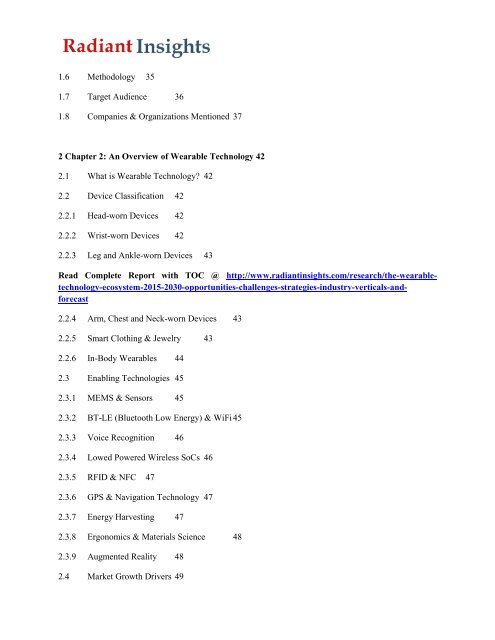The Wearable Technology Ecosystem Market Size, Share, Growth, Trend 2015 – 2030 Radiant Insights, Inc
While wearable technology has been utilized in vertical sectors such as the military and healthcare for many years, ongoing advances have triggered a major resurgence of the concept, particularly among the consumer community. Key enabling technologies including low cost sensors, wireless connectivity, active materials and energy have converged to make wearable technology mainstream. With the continued miniaturization of enabling technologies, wearable devices have hit the mass market in a diverse variety of form factors, ranging from glasses to even jewelry. Read Complete Report with TOC @ http://www.radiantinsights.com/research/the-wearable-technology-ecosystem-2015-2030-opportunities-challenges-strategies-industry-verticals-and-forecast Driven by the ability to interconnect with key modern trends of healthcare, fitness, messaging and socialization, the wearable technology ecosystem is attracting significant levels of interest. Companies as varied as smartphone OEMs, wireless carriers, health insurers and retailers are circling the ecosystem alongside tiny startups, all vying for a stake. SNS Research estimates that by 2016, wearable device shipments will surpass 140 Million and will account for nearly $30 Billion in revenue. The market is further expected to grow at a CAGR of 30% over the next five years. The “Wearable Technology Ecosystem: 2015 – 2030 – Opportunities, Challenges, Strategies, Industry Verticals & Forecasts” report presents an in-depth assessment of the wearable technology ecosystem including key market drivers, challenges, investment potential, consumer & vertical market opportunities, use cases, future roadmap, value chain, case studies, vendor market share and strategies. The report also presents forecasts for wearable device shipments and revenue from 2015 through to 2030. The forecasts are further segmented for 7 device form factor submarkets, 7 vertical markets, 6 regions and 73 countries.
While wearable technology has been utilized in vertical sectors such as the military and healthcare for many years, ongoing advances have triggered a major resurgence of the concept, particularly among the consumer community. Key enabling technologies including low cost sensors, wireless connectivity, active materials and energy have converged to make wearable technology mainstream.
With the continued miniaturization of enabling technologies, wearable devices have hit the mass market in a diverse variety of form factors, ranging from glasses to even jewelry.
Read Complete Report with TOC @
http://www.radiantinsights.com/research/the-wearable-technology-ecosystem-2015-2030-opportunities-challenges-strategies-industry-verticals-and-forecast
Driven by the ability to interconnect with key modern trends of healthcare, fitness, messaging and socialization, the wearable technology ecosystem is attracting significant levels of interest. Companies as varied as smartphone OEMs, wireless carriers, health insurers and retailers are circling the ecosystem alongside tiny startups, all vying for a stake.
SNS Research estimates that by 2016, wearable device shipments will surpass 140 Million and will account for nearly $30 Billion in revenue. The market is further expected to grow at a CAGR of 30% over the next five years.
The “Wearable Technology Ecosystem: 2015 – 2030 – Opportunities, Challenges, Strategies, Industry Verticals & Forecasts” report presents an in-depth assessment of the wearable technology ecosystem including key market drivers, challenges, investment potential, consumer & vertical market opportunities, use cases, future roadmap, value chain, case studies, vendor market share and strategies. The report also presents forecasts for wearable device shipments and revenue from 2015 through to 2030. The forecasts are further segmented for 7 device form factor submarkets, 7 vertical markets, 6 regions and 73 countries.
You also want an ePaper? Increase the reach of your titles
YUMPU automatically turns print PDFs into web optimized ePapers that Google loves.
1.6 Methodology 35<br />
1.7 Target Audience 36<br />
1.8 Companies & Organizations Mentioned 37<br />
2 Chapter 2: An Overview of <strong>Wearable</strong> <strong>Technology</strong> 42<br />
2.1 What is <strong>Wearable</strong> <strong>Technology</strong>? 42<br />
2.2 Device Classification 42<br />
2.2.1 Head-worn Devices 42<br />
2.2.2 Wrist-worn Devices 42<br />
2.2.3 Leg and Ankle-worn Devices 43<br />
Read Complete Report with TOC @ http://www.radiantinsights.com/research/the-wearabletechnology-ecosystem-<strong>2015</strong>-<strong>2030</strong>-opportunities-challenges-strategies-industry-verticals-andforecast<br />
2.2.4 Arm, Chest and Neck-worn Devices 43<br />
2.2.5 Smart Clothing & Jewelry 43<br />
2.2.6 In-Body <strong>Wearable</strong>s 44<br />
2.3 Enabling Technologies 45<br />
2.3.1 MEMS & Sensors 45<br />
2.3.2 BT-LE (Bluetooth Low Energy) & WiFi 45<br />
2.3.3 Voice Recognition 46<br />
2.3.4 Lowed Powered Wireless SoCs 46<br />
2.3.5 RFID & NFC 47<br />
2.3.6 GPS & Navigation <strong>Technology</strong> 47<br />
2.3.7 Energy Harvesting 47<br />
2.3.8 Ergonomics & Materials Science 48<br />
2.3.9 Augmented Reality 48<br />
2.4 <strong>Market</strong> <strong>Growth</strong> Drivers 49


















